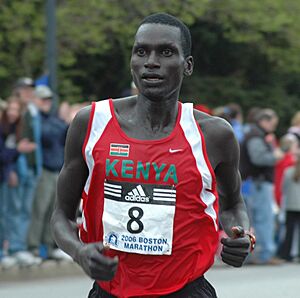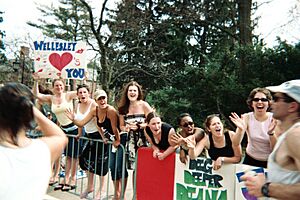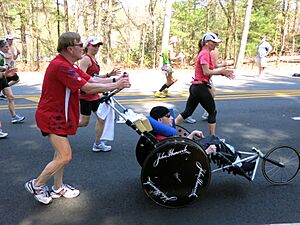Boston Marathon facts for kids
Quick facts for kids Boston Marathon |
|
|---|---|

Current logo, introduced in June 2024
|
|
| Date | Usually the third Monday of April (Patriots' Day) |
| Location | Eastern Massachusetts, ending in Boston |
| Event type | Road |
| Distance | Marathon |
| Established | 1897 |
| Course records | Men: 2:03:02 (2011) Geoffrey Mutai Women: 2:17:22 (2025) Sharon Lokedi |
The Boston Marathon is a famous long-distance running race held every year in Massachusetts, United States. It takes place on Patriots' Day, which is the third Monday in April. This race started in 1897 and was inspired by the first marathon at the 1896 Summer Olympics. It is the oldest yearly marathon in the world and one of the most well-known road races. The Boston Marathon is also one of the seven World Marathon Majors, which are the biggest marathons globally. The course starts in Hopkinton and finishes in Copley Square in Boston.
The Boston Athletic Association (B.A.A.) has organized this event every year since 1897. Even when the 2020 race was canceled due to the COVID-19 pandemic, they held a "virtual alternative." Runners from all over the world come to compete, facing the hilly roads and changing weather in Massachusetts.
About 500,000 people watch the race along the route. This makes it New England's most-watched sports event. In 1897, only 15 people ran. Now, about 30,000 runners sign up each year. In 1996, the 100th Boston Marathon set a record with 38,708 people entering.
Contents
- History of the Boston Marathon
- Women in the Race: Bobbi Gibb, Kathrine Switzer, and Nina Kuscsik
- Rosie Ruiz: The Impostor Runner
- Sad Moments: Participant Deaths
- 2011: Geoffrey Mutai's Fast Run
- 2013: The Bombing Incident
- 2014: Women's Race Disqualification
- 2016: Bobbi Gibb as Grand Marshal
- 2020: Race Canceled
- 2021: Race Moved to October
- How to Qualify for the Race
- Race Day Details
- The Boston Athletic Association (B.A.A.)
- Different Race Divisions
- Boston Marathon Memorial
- Special Features of the Race
- See also
History of the Boston Marathon
Men have run in the Boston Marathon since it first started in 1897. Women were officially allowed to enter the race starting in 1972. However, the organizers now recognize 1966 as the first year a woman officially completed the race.
Wheelchair divisions were added in 1975 for men and in 1977 for women. The first person to officially race in a wheelchair was Bob Hall. Handcycle divisions, for bikes powered by arms, were added in 2017 for both men and women.
The Boston Marathon was first run in April 1897. It was inspired by the marathon race at the first modern Olympic Games in Athens, Greece, in 1896. Until 2020, it was the oldest marathon that had been run every single year.
The first race was 24.5 miles long. John J. "JJ" McDermott won the first race in 1897, finishing in 2 hours, 55 minutes, and 10 seconds. He was one of 15 runners. The race was set for Patriots' Day, a holiday celebrating American freedom. In 1924, the starting line moved to Hopkinton. The course was also made longer, to 26 miles and 385 yards, to match the standard marathon distance.
At first, the Boston Marathon was a local event. But it became famous and attracted runners from all over the world. For most of its history, it was free to enter. The winner only received a wreath made of olive branches. However, in the 1980s, professional athletes wanted cash prizes. So, money awards began in 1986.
During the Korean War in 1951, the president of the Boston Athletic Association, Walter A. Brown, did not allow Korean runners to enter. He said that Koreans should be fighting for their country.
Women in the Race: Bobbi Gibb, Kathrine Switzer, and Nina Kuscsik
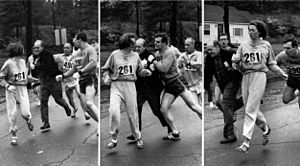
Before 1967, the Boston Marathon rules did not mention gender. In 1966, Roberta "Bobbi" Gibb tried to sign up but was told women could not run 26 miles. She ran anyway without a race number and finished ahead of many men. Later, race organizers recognized her as the first woman to run the entire Boston Marathon.
In 1967, Kathrine Switzer signed up using her initials, K. V. Switzer. She was the first woman to run and finish with a valid official race number. During the race, an official tried to pull off her numbers and remove her from the race. Switzer still finished. After this, the rules were changed to ban women from competing in races against men. However, Switzer and the official later became friends.
Nina Kuscsik helped change the rules in 1971. This allowed women to officially participate in marathons, including Boston, starting in 1972. Kuscsik was the first woman to officially win the Boston Marathon in 1972.
In 1996, the B.A.A. officially recognized the women who led the unofficial races from 1966 to 1971 as champions. By 2022, about 43 percent of the runners were women.
Rosie Ruiz: The Impostor Runner
In 1980, Rosie Ruiz crossed the finish line first in the women's race. But officials became suspicious. They found she did not appear in race videos until near the end. An investigation showed she had skipped most of the race. She joined the crowd about half a mile from the finish line and then ran to "win." She was disqualified eight days later. The real winner was Jacqueline Gareau from Canada.
Sad Moments: Participant Deaths
Sadly, a few runners have died during or after the Boston Marathon. In 1905, James Edward Brooks died of pneumonia. In 1996, Humphrey Siesage, a 61-year-old man, died of a heart attack during the 100th race. In 2002, Cynthia Lucero, 28, died from a condition called hyponatremia, which is when salt levels in the body become too low.
2011: Geoffrey Mutai's Fast Run
On April 18, 2011, Geoffrey Mutai from Kenya won the 2011 Boston Marathon in 2 hours, 3 minutes, and 2 seconds. This was the fastest marathon ever run at that time. However, it was not recognized as a world record. This is because the Boston course goes downhill a lot and the start and finish lines are far apart. These factors can give runners an advantage, especially with a strong tailwind.
2013: The Bombing Incident
On April 15, 2013, the 2013 Boston Marathon was still happening. Two homemade bombs exploded near the finish line. The race was stopped, and many runners could not finish. Three spectators died, and about 264 people were hurt. Runners who had completed at least half the course but could not finish due to the bombing were given automatic entry into the 2014 race.
One of the people responsible for the bombing, Dzhokhar Tsarnaev, was found guilty in 2015. His older brother, Tamerlan, died after a fight with police.
2014: Women's Race Disqualification
Bizunesh Deba of Ethiopia was named the women's winner of the 2014 Boston Marathon. This happened after Rita Jeptoo from Kenya was disqualified for breaking anti-doping rules. Deba finished in 2 hours, 19 minutes, and 59 seconds. Her time became the new course record for women.
2016: Bobbi Gibb as Grand Marshal
In the 2016 Boston Marathon, Jami Marseilles became the first female double amputee to finish the race. Bobbi Gibb, the first woman to run the entire Boston Marathon (in 1966), was the grand marshal. The winner of the Women's Open division, Atsede Baysa, gave her trophy to Gibb.
2020: Race Canceled
Due to the COVID-19 pandemic, the 2020 Boston Marathon was first moved from April 20 to September 14. This was the first time in over 100 years that the race was postponed.
On May 28, 2020, it was announced that the race was canceled completely. Boston Mayor Marty Walsh said it was not safe to hold the race with so many people close together. Runners received full refunds. Organizers then held a "virtual alternative" in September 2020. This was the second time the race format was changed. The first was in 1918, during World War I, when it was a military relay race.
2021: Race Moved to October
On October 28, 2020, the B.A.A. announced that the 2021 marathon would not be in April. They hoped to hold it later in the year, possibly in the fall. In January 2021, October 11 was set as the date. The number of runners was limited to 20,000. The B.A.A. also offered a virtual race option for 2021.
How to Qualify for the Race
| Age | Men | Women |
|---|---|---|
| 18–34 | 2 h 55 min | 3 h 25 min |
| 35–39 | 3 h 00 min | 3 h 30 min |
| 40–44 | 3 h 05 min | 3 h 35 min |
| 45–49 | 3 h 15 min | 3 h 45 min |
| 50–54 | 3 h 20 min | 3 h 50 min |
| 55–59 | 3 h 30 min | 4 h 00 min |
| 60–64 | 3 h 50 min | 4 h 20 min |
| 65–69 | 4 h 05 min | 4 h 35 min |
| 70–74 | 4 h 20 min | 4 h 50 min |
| 75–79 | 4 h 35 min | 5 h 05 min |
| ≥80 | 4 h 50 min | 5 h 20 min |
The Boston Marathon is open to runners aged 18 or older from any country. However, runners must meet certain qualifying standards. To qualify, a runner must complete another official marathon within a specific time before the Boston Marathon. This usually means within about 18 months.
In 2011, the qualifying times for the 2013 race were made five minutes faster for each age group. For example, men aged 18-34 had to run a marathon in 3 hours or less. Women in the same age group had to run in 3 hours and 30 minutes or less. The qualifying time gets longer as runners get older. For many marathoners, qualifying for Boston is a big goal.
Not all runners have to meet these times. About one-fifth of the spots are saved for charities and sponsors. In 2010, about 5,470 runners entered through partners, including 2,515 charity runners. Charities are expected to raise millions of dollars each year. In 2017, charity runners raised $34.2 million for over 200 non-profit groups.
In 2010, the 20,000 spots for qualified runners filled up in a record 8 hours and 3 minutes. Because of this, the B.A.A. changed its rules for the 2013 marathon. They made qualifying times faster and started a "rolling application" process. This means faster runners get priority.
In September 2018, the B.A.A. made the qualifying times for the 2020 marathon five minutes faster again. For the 2026 race, which is coming up, the times were lowered by another five minutes for most age groups. For example, men aged 18-34 need to run in 2 hours and 55 minutes or less.
Race Day Details
The race is always held on Patriots' Day, a state holiday in Massachusetts. Until 1968, this holiday was always on April 19. Since 1969, it has been on the third Monday in April. People often call this day "Marathon Monday."
Starting Times
Before 2006, the race started at noon. Wheelchair racers and elite women started earlier. In 2006, the race began using "wave starts." This means groups of runners start at different times to reduce crowding. The starting times were moved earlier in later years to take advantage of cooler weather. More waves were added to help spread out the runners.
For example, the starting times for 2019 were:
- Men's Push Rim Wheelchair: 9:02 a.m.
- Women's Push Rim Wheelchair: 9:04 a.m.
- Handcycles and Duos: 9:25 a.m.
- Elite Women: 9:32 a.m.
- Elite Men: 10 a.m.
- Wave One: 10:02 a.m.
- Wave Two: 10:25 a.m.
- Wave Three: 10:50 a.m.
- Wave Four: 11:15 a.m.
The Course Route
The course is 26 miles and 385 yards long. It winds through eight cities and towns in Massachusetts. These include Hopkinton, Ashland, Framingham, Natick, Wellesley, Newton, Brookline, and Boston. The official finish line is at Copley Square in Boston.
The Boston Marathon is known as a difficult course because of the "Newton hills." These hills are near Boston College. The most famous is Heartbreak Hill. However, the race director, Dave McGillivray, says an earlier hill on Washington Street is the hardest. This hill forces many runners to walk.
Heartbreak Hill
Heartbreak Hill is a climb of about 0.4 miles between the 20- and 21-mile marks. It is the last of four "Newton hills." These hills challenge runners after the course has generally been downhill. Even though Heartbreak Hill only rises 88 feet, it comes at a point in the race where runners are often very tired. This is sometimes called "hitting the wall."
The hill got its name in 1936. The defending champion, John A. "Johnny" Kelley, passed another runner, Ellison "Tarzan" Brown, and patted him on the shoulder. This made Brown determined to win. He pulled ahead of Kelley and won the race. People said he "broke Kelley's heart."
Race Records
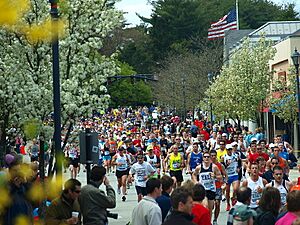
The Boston Marathon course goes downhill from start to finish. Also, the start is west of the finish, which can mean a helpful tailwind. Because of these reasons, times set in Boston cannot be official world records.
At the 2011 Boston Marathon, Geoffrey Mutai ran in 2 hours, 3 minutes, and 2 seconds. This was the fastest marathon time ever at that point. But it was not an official world record due to the course rules. Bezunesh Deba set the women's course record in 2014 with a time of 2 hours, 19 minutes, and 59 seconds. This happened after another runner was disqualified.
Other course records include:
- Men's Masters (older runners): John Campbell (New Zealand), 2:11:04 (1990)
- Women's Masters: Firiya Sultanova-Zhdanova (Russia), 2:27:58 (2002)
- Men's Push Rim Wheelchair: Marcel Hug (Switzerland), 1:17:06 (2023)
- Women's Push Rim Wheelchair: Manuela Schär (Switzerland), 1:28:17 (2017)
- Men's Handcycle: Tom Davis (United States), 0:58:36 (2017)
- Women's Handcycle: Alicia Dana (United States), 1:18:15 (2023)
Only four times have world record times been set in Boston. In 1947, Suh Yun-Bok from South Korea set the men's record. In 1975, Liane Winter from West Germany set a women's world record. In 1983, Joan Benoit Samuelson from the United States set another women's world record. In 2012, Joshua Cassidy from Canada set a men's wheelchair marathon world record.
In 2007, astronaut Sunita Williams ran the marathon distance while on the International Space Station. She was the first person to run a marathon in space. The B.A.A. sent her a special race number and medal.
The Boston Athletic Association (B.A.A.)
The Boston Athletic Association is a non-profit sports group. It organizes the Boston Marathon and other events.
Different Race Divisions
The 1975 Boston Marathon was the first major marathon to include a wheelchair division. Bob Hall asked to compete in his wheelchair. He finished in 2 hours and 58 minutes, which helped create the wheelchair division. Ernst Van Dyk set a course record in 2004, finishing almost 50 minutes faster than the fastest runner.
Also in 1975, the Boston Marathon added a women's masters division for older runners. Sylvia Weiner, at age 44, won it.
Handcyclists have raced since at least 2014. Since 2017, handcyclists are honored like runners and wheelchair racers. They receive wreaths, prize money, and their national anthems are played.
Besides the wheelchair division, the Boston Marathon also has divisions for blind/visually impaired runners and mobility impaired runners. These divisions have qualifying times too. In 1986, the wheelchair division became the richest in the sport when prize money was introduced. In 2013, 40 blind runners participated.
A nonbinary division was first included in 2023. Kae Ravichandran won it with a time of 2:38:57.
Boston Marathon Memorial
There is a Boston Marathon Memorial in Copley Square, near the finish line. It was built to mark the 100th running of the race. It has granite blocks and a central medal that shows the race course and names of winners.
Special Features of the Race
Spectators and Fans
With about 500,000 spectators, the Boston Marathon is New England's most-watched sports event. Thousands of people line the course to cheer on the runners. They also offer free water and snacks.
The Scream Tunnel
At Wellesley College, a women's college, students have a tradition called the Scream Tunnel. For about a quarter of a mile, students line the course, screaming loudly and offering kisses. Runners say the Scream Tunnel is so loud they can hear it from a mile away. It is about half a mile before the halfway point of the race.
Boston Red Sox Game
Every year, the Boston Red Sox baseball team plays a home game at Fenway Park on Marathon Monday. The game starts at 11:05 a.m. When the game ends, the crowd leaves the park and cheers for the runners entering the final mile. This tradition began in 1903.
Dick and Rick Hoyt: Team Hoyt
Dick and Rick Hoyt ran the Boston Marathon 32 times. Dick was Rick's father. Rick had cerebral palsy. Doctors thought Rick would not have a normal life, but his parents raised him at home. Rick later used a computer to communicate. He loved sports. "Team Hoyt" (Dick pushing Rick in a wheelchair) started competing in races. They completed their 30th Boston Marathon in 2012. They planned for 2013 to be their last, but the Boston Marathon bombing stopped them short. So, they ran one more time in 2014. Dick was named the Grand Marshal of the 2015 marathon. Dick passed away in 2021, and Rick passed away in May 2023.
Bandit Runners
The Boston Marathon used to allow "bandits." These were runners who did not officially register or have a race number. They would start after all the official runners. For many years, these unofficial runners were seen as local heroes. The current race director, Dave McGillivray, was once a teenage bandit.
However, after the 2013 bombing, organizers decided to discourage bandits. The B.A.A. website now states that unofficial runners should not participate. This is because race services like water, medical care, and safety are planned for the official number of runners. More people can make the race less safe for everyone.
Costumes in the Race
Some people run the marathon in costumes. In 1996, during the 100th race, one runner wore a model of the Old North Church steeple. This church is famous for a signal that started Paul Revere's ride, which is celebrated on Patriots' Day. After the 2013 bombing, runners and spectators were asked not to wear costumes that covered their faces or were bulky. This was for security reasons.
Ondekoza Drummers

Since 1975, members of Ondekoza, a group from Japan, have run the marathon. After finishing, they would play their taiko drums at the finish line. They did this several times in the 1970s and 1990s. A large drum, weighing 700 pounds, would be set up to cheer on finishing runners.
See also
 In Spanish: Maratón de Boston para niños
In Spanish: Maratón de Boston para niños
- List of winners of the Boston Marathon
- List of marathon races in North America
- The Sports Museum (at TD Garden)




